Yves GARY Hits: 7089
Category: SKIPPERS & CREWS
 Skipper of RESOLUTE (1920) and YANKEE (1930 & 1934)
Skipper of RESOLUTE (1920) and YANKEE (1930 & 1934)Charles Francis Adams III (August 2, 1866 – June 10, 1954) was the United States Secretary of the Navy under President Herbert Hoover and a well-known yachtsman. Charlie Adams, as he is known among his friends, is the head of the Adams family, one that has been famous in the history of this country.
His great-great-grandfather was John Adams, the second President of this country and one of the signers of the Declaration of Independence, and his great-grandfather was John Quincy Adams, the sixth President. His grandfather was Charles Francis Adams, Minister of the United States to Great Britain during the civil war and head of the United States delegation to the Geneva Tribunal, 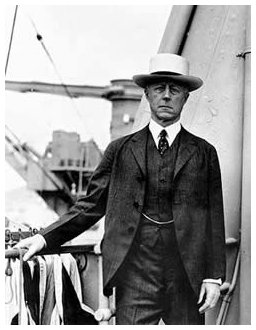 the first International arbitration court, which settled the Alabama claims.
the first International arbitration court, which settled the Alabama claims.
Adams graduated cum laude from Harvard College in 1888 and from Harvard Law School in 1892. He was first a lawyer, then went into business. He married Frances Lovering, the daughter of U.S. Representative William C. Lovering, in 1899. They had one son, Charles, and one daughter, Catherine.
Adams served as mayor of Quincy, Massachusetts from 1896 to 1897. As Secretary of the Navy, from 1929 to 1933, he vigorously promoted public understanding of the Navy's indispensable role in international affairs, and worked strenuously to maintain naval strength and efficiency during a period of severe economic depression. He served at the London Naval Conference in 1930 where he successfully maintained the principle of United States naval parity with Britain.
He died in 1954 and is interred in Mount Wollaston Cemetery in Quincy, Norfolk County, Massachusetts next to his father, Charles Francis Adams, Jr., and his grandfather, Charles Francis Adams, Sr.
The "Dean of American Helmsmen" was inducted into the America's Cup Hall of Fame (1993).The Charles Francis Adams Memorial Trophy for yacht racing was established in his memory, and the Navy destroyer USS Charles F. Adams was named after him.
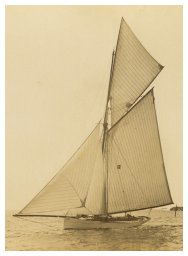 He began sailing a small catboat 18 feet long in 1880 and with his brothers raced in Hull Bay. The catboat was named Dandelion and was very successful. In 1885 the Adams brothers secured the sloop Cricket. She was 30 feet long and was raced with varying success until 1887.
He began sailing a small catboat 18 feet long in 1880 and with his brothers raced in Hull Bay. The catboat was named Dandelion and was very successful. In 1885 the Adams brothers secured the sloop Cricket. She was 30 feet long and was raced with varying success until 1887.
At that time, the Herreshoff sloop Shadow had been winning everything in Massachusetts Bay, and the Adams boys went to Burgess, who turned out for them the Papoose which lowered the colors of the Shadow. Charles Francis Adams then had the Baboon, a 40 footer, built and it won many prizes. In 1889 Mr. Adams went to England and studied yachting there. He sailed the cutter Irex, the 49 footer Dragoon and the 10 rater Yvonne and learned much of British methods.
 In the meantime the Minerva had been brought to this country and was winning everything. In 1890 Mr. Adams had the Gossoon built. After a very active season the Gossoon and Minerva were tied. Next the 46 footer Beatrix was purchased and named Harpoon and was sailed by Mr. Adams against the Gloriana, sailed by capt. John Barr, and the Wasp, sailed by Charley Barr who was then becoming prominent as a skipper.
In the meantime the Minerva had been brought to this country and was winning everything. In 1890 Mr. Adams had the Gossoon built. After a very active season the Gossoon and Minerva were tied. Next the 46 footer Beatrix was purchased and named Harpoon and was sailed by Mr. Adams against the Gloriana, sailed by capt. John Barr, and the Wasp, sailed by Charley Barr who was then becoming prominent as a skipper.
For many years Mr. Adams was president of the Yacht Racing Association of Massachusetts Bay. He took a prominent part in the formation of the 21 foot class and owned the Chinook and the Booster and then took an active part in the sander class. 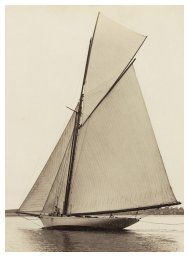 First he owned the Auk, which was beaten, and later he won the President Taft cup with the Harpoon. Mr. Adams has one superstition. The names of his yachts must have seven letters and must have the double o. Those so named have been very successful.
First he owned the Auk, which was beaten, and later he won the President Taft cup with the Harpoon. Mr. Adams has one superstition. The names of his yachts must have seven letters and must have the double o. Those so named have been very successful.
In the race of 1906 with the Germans Mr. Adams was sailing the Auk against the Vim, as the final result depended on the position in which these two finished in the race. The other boats were beaten. The Vim was a Gardner boat owned by Trenor L. Park. The fight was a hot one. Vim held the lead and Auk was trying to get by to windward. A luffing match followed and then those watching the race saw the Auk bear away and head for the harbor: she had given up the race. Later Mr. Adams was asked why he had quit. 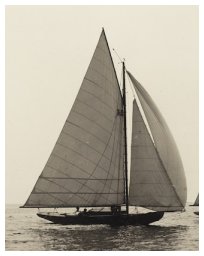 He said that in luffing his head-stay had caught the end of the Vim's boom. He had fouled and was out of the race from that time.
He said that in luffing his head-stay had caught the end of the Vim's boom. He had fouled and was out of the race from that time.
He might have continued and waited for his opponent to protest, but Mr. Adams's idea of yacht racing is that each yachtsman should see that the rules are carried out and when a foul or an infringement of a rule is committed the yachtsman should withdraw at once and not injure the chances of other yachts.
Mr. Adams has raced yachts of all sizes and has probably had more experience than any other yachtsman in the country. He has the nerve necessary to handle a big sloop and thoroughly understands the racing rules so that he can judge quickly the right thing to do. He thinks quickly and acts quickly and in yachting things happen so quickly that quick thought and action are necessary to success. Mr Adams is a wonder in sailing a yacht to windward. He has the rare faculty of paying no attention to his rival after he has started. Many yachtsmen when in close company will begin to worry about what their opponent will do, but with Mr. Adams this is the last thing he thinks about. He is bent on making the best of his way to the mark and nothing disturbs his work.
 La première participation de Charles Francis Adams à la Coupe de l’America remonte à 1893 ou, avec son frère George, ils faisaient partie de la cellule arrière de PILGRIM. Pilgrim was managed by George Stewart, Charles Francis Adams 2d, of Boston, an able Corinthian sailor, had charge of her in her races. Her sailing-master was Capt. Edward Sherlock. Mais ce bateau novateur sera très difficile à mettre au point et il n’aura pas les résultats qu’on aurait pu espérer.
La première participation de Charles Francis Adams à la Coupe de l’America remonte à 1893 ou, avec son frère George, ils faisaient partie de la cellule arrière de PILGRIM. Pilgrim was managed by George Stewart, Charles Francis Adams 2d, of Boston, an able Corinthian sailor, had charge of her in her races. Her sailing-master was Capt. Edward Sherlock. Mais ce bateau novateur sera très difficile à mettre au point et il n’aura pas les résultats qu’on aurait pu espérer.
Charles Francis Adams was the first amateur skipper of an America's Cup defender. Mr. Robert W. Emmons 2d secured Charles Francis Adams 2d to act as helmsman of the RESOLUTE. In doing so he broke all tradition. He firmly believed that Mr. Adams would handle the yacht more skilfully than any professional and determined to make the America's cup race an amateur event, and in this he has been supported by Sir Thomas Lipton. His defense of the America's Cup in 1920 aboard RESOLUTE was one of the most tense in America's Cup history. RESOLUTE lost the first two races to Lipton's SHAMROCK IV, then came back to win three races in a row to keep the Cup on this side of the Atlantic.
Charles Francis Adams will participated with YANKEE at the selections of 1930 and 1934. If the selection of ENTERPRISE in 1930 was sportingly acknowledged by Charles Francis Adams, the selection of RAINBOW in 1934 will be much disputed and even questionable. Only a small second has prevented Charles Francis Adams to become the oldest skipper (68) in a final of the America's Cup.
RESOLUTE - 1920 |
YANKEE - 1930 & 1934 |
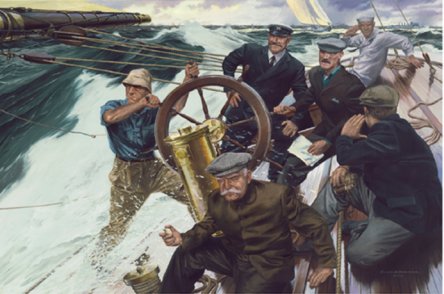 |
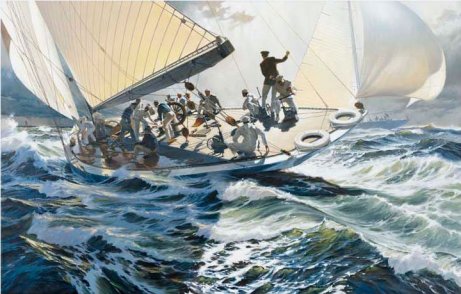 |
| “The Afterguard”
By Russ Kramer Oil on linen, 42” x 29” Charles Francis Adams, grandson of John Quincy Adams and the first amateur skipper to defend the America’s Cup, holds RESOLUTE on a broad reach during the squally homeward leg of the fourth race against SHAMROCK IV , 23 July, 1920. |
“A Desperate Battle: Yankee Vies to Defend the Cup, 1934” By Russ Kramer Oil on Linen, 28" x 44" The America’s Cup trials of 1934 were closer than any before or since. YANKEE, the Boston syndicate boat, under owner Chandler Hovey and helmed by Charles Frances Adams, had the upper hand throughout the Summer. But, after Mike Vanderbilt ordered RAINBOW to be re-ballasted, she soon drew even in matches. All tied up going into the final race, RAINBOW would win it by a single second, and when chosen over YANKEE to defend, it was a crushing blow to the team from Marblehead. |
These two defeats do not discourage Charles Francis Adams, who will continue to race and win races until the eve of the war :
July 05, 1939 - 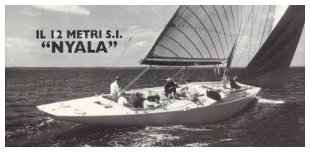 ADAMS REGAINS TROPHY; His Thisbe Takes Puritan Cup at Marblehead Third Time. Forty-six years ago Charles Francis Adams won the Puritan Cup for the second time with the cutter Harpoon.
ADAMS REGAINS TROPHY; His Thisbe Takes Puritan Cup at Marblehead Third Time. Forty-six years ago Charles Francis Adams won the Puritan Cup for the second time with the cutter Harpoon.
August 10, 1939 - ADAMS HOME FIRST IN 12-METER NYALA; America's Cup Skipper of 19 Years Ago Wins on Second Run of N.Y.Y.C. Cruise ANNEXES CHALLENGE CUP.
August 12, 1939 - Astor Cup Yacht Races Taken by Nyala and Nina; EVENT FOR SLOOPS IS WON BY NYALA Yacht Chartered by Adams Is Victor Off Newport.
VINEYARD HAVEN, Mass., Aug. 12, 1939 - SLOOP NYALA FIRST IN CRUISE CONTEST; Adams Sails 12-Meter Craft to Vineyard Haven Ahead of N.Y.Y.C. Fleet.
NEWPORT, R.I., Aug. 17, 1939- Nyala, Skippered by Adams, Runs Away From Rivals for King's Cup; Sloop Leads Seven Seas by 17:39 in N.Y.Y.C. Cruise Event.
August 09, 1940 - 632 YACHTS IN REGATTA; Adams Again Wins his fifth victory in as many days With Thisbe in Race Off Marblehead.

PERSONALITIES BEHIND THE STRUGGLE FOR THE CUP - The Sun August 9, 1914
- Charles Francis Adams III - Wikipedia, the free encyclopedia
- Charles Francis "Deacon" Adams, III (1866 - 1954) - Genealogy
- Charles Francis Adams, 1993 Inductee - Herreshoff Marine Museum & America's Cup Hall of Fame
- Charles Francis Adams III - NNDB: Tracking the entire world
- Charles Francis Adams III | United States official - Britannica.com
- Charles F.Adams.チャールズ・F・アダムス.The Naval Data Base - :近代世界艦船事典The Encyclopedia of World ,Modern Warships
